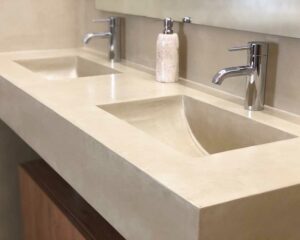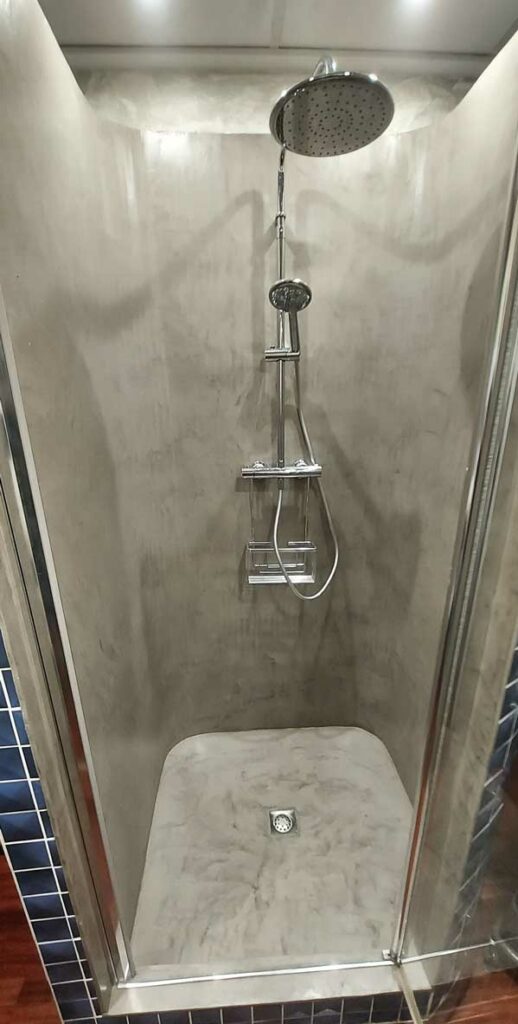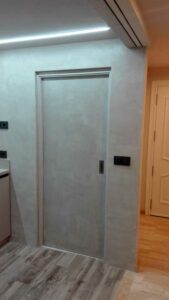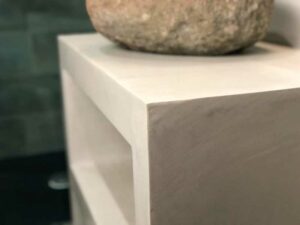
Washbasin Cabinet
Washbasin Cabinet Sinks of all kinds When it comes to reforming the bathroom, one of the elements that should be seen and decided is the
Humidity and Microcement: One of the main challenges we can face with microcement is dealing with humidity. Although the microcement we use at CimentStudio is waterproof, it’s still important to address any moisture issues correctly. Let us clarify this.
Is it problematic to apply microcement in humid areas like a shower? Absolutely not. When the microcement is of high quality and properly applied, it will last for many years, whether in a home or commercial space.
The real concern with humidity arises from the surface beneath the microcement. A common issue we encounter is rising damp, particularly in older buildings. Our recommendation is to always address this problem before applying microcement, without resorting to temporary fixes. If you suspect you have this issue, contact us for advice on the best long-term solutions.

In addition to capillary moisture, another critical issue we often encounter is the application of microcement on surfaces that have not fully cured. This is especially important for surfaces containing cement, such as concrete, which must be allowed to fully cure before the microcement can be applied. Failure to do so can lead to significant problems down the line.
Concrete, for example, typically requires about 28 days to cure completely, depending on environmental conditions such as temperature and humidity. During this curing process, the concrete releases moisture. If microcement is applied too soon, the subsequent layers, especially when combined with a protective varnish, create a vapor barrier. This barrier traps any residual moisture within the concrete, and as the water tries to evaporate, it exerts pressure on the microcement layer. This can lead to the formation of unsightly stains, cracks, or even bubbling, compromising the appearance and durability of the finish.
Moreover, improper curing can weaken the bond between the concrete and the microcement, leading to delamination, where the microcement layer separates from the base. This not only affects aesthetics but also reduces the longevity and strength of the application.
In addition to ensuring proper curing, it’s essential to consider the environmental humidity during the application process. High humidity levels can extend the drying times of the microcement layers, making it crucial to wait for each layer to dry completely before applying the next. Rushing this process can result in a finish that lacks the necessary hardness and durability, leading to premature wear or damage.
It’s also crucial to control environmental humidity during application. Excess humidity can extend drying times, affecting how successive layers are applied. If layers are applied before fully drying, the system won’t achieve the necessary hardness, leading to structural weaknesses and potential application failures.
For more details and advice, visit our CimentStudio website to explore solutions tailored to your needs.

Washbasin Cabinet Sinks of all kinds When it comes to reforming the bathroom, one of the elements that should be seen and decided is the

Reform Doors with Microcement Restore doors with microcement When applying microcement on a door, the best option is undoubtedly a smooth sliding door. Although outside

Top Microcement Uses: Washbasins, Shower trays, Furniture, Countertops Washbasins in Microcement Nowadays and more and more, new materials are being sought for our home, and